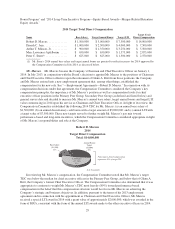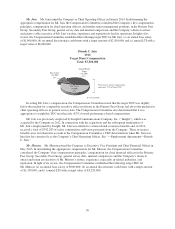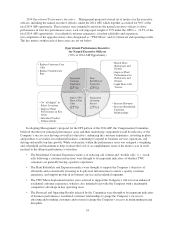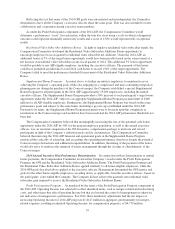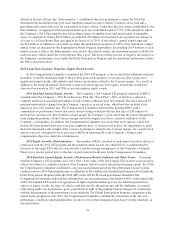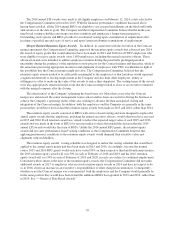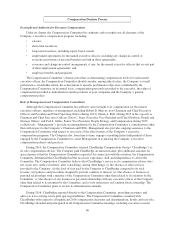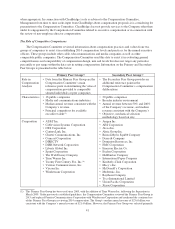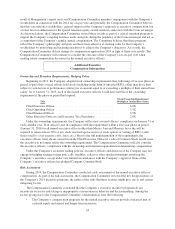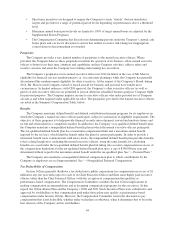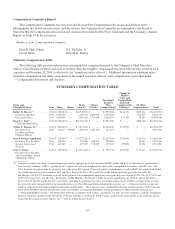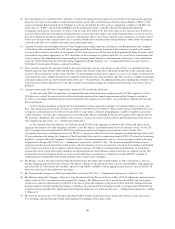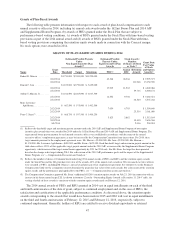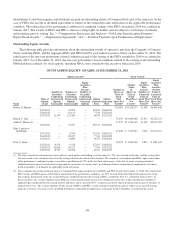Time Warner Cable 2015 Annual Report Download - page 44
Download and view the complete annual report
Please find page 44 of the 2015 Time Warner Cable annual report below. You can navigate through the pages in the report by either clicking on the pages listed below, or by using the keyword search tool below to find specific information within the annual report.defined in Section 162(m) (the “Subcommittee”), established objective performance criteria for 2014 that
determined the maximum bonus pool from which the named executive officers’ bonuses can be paid and a
percentage allocation of the pool for each named executive officer. Under the objective criteria established by the
Subcommittee, an aggregate 2014 maximum bonus pool was established equal to 7.5% of the amount by which
the Company’s 2014 Operating Income before depreciation of tangible assets and amortization of intangible
assets (as adjusted) of at least $8.15 billion exceeded $6.723 billion. Each annual bonus payment was subject in
all cases to a 162(m) Bonus Plan cap equal to the lesser of (i) 250% of the officer’s annual bonus target and
(ii) $15 million, in addition to an overall cap under the annual bonus program of 150% of the individual’s target
annual bonus (as increased by the Supplemental Bonus Program opportunity). In awarding 2014 bonuses to each
named executive officer, the Subcommittee exercised its discretion to reduce the maximum amount available for
each executive officer under the 162(m) Bonus Plan’s pool. The basis for this exercise of negative discretion was
the Company’s performance score under the Profit Participation Program and the operational performance under
the OPI as described above.
2014 Long-Term Incentive Program—Equity-Based Awards
As the Compensation Committee considered the 2014 LTI program, it also realized that additional retention
incentives would be essential in light of the possible protracted regulatory review process that is typical for
significant mergers in the cable industry and various uncertainties related to the Comcast merger. As a result, in
addition to the standard annual LTI awards, it approved advancing into 2014 equity awards that would have
otherwise been made in 2015 and 2016 as special retention equity awards.
2014 Standard Annual Equity Awards.The Company’s 2014 Annual LTI program consisted of RSUs
awarded under the Company’s 2011 Stock Incentive Plan (the “Stock Plan”), 60% of which was subject to
complete forfeiture if specified performance-based vesting conditions were not satisfied. The 2014 annual LTI
program represented a change from the Company’s practices in recent years, which had also included stock
options as part of its standard mix. The Compensation Committee believed that granting RSUs with a
combination of performance-based and service-based vesting would provide the best mix of LTI vehicles to
motivate key executives to drive business results against the Company’s goals and retain the senior management
team during the pendency of the Comcast merger and better aligned executives’ interests with those of the
Company’s stockholders. In addition, the Compensation Committee was aware that stock options, which had
historically been granted with a ten-year term, might not have, or be perceived to have, the opportunity to reach
their full anticipated value in light of the various circumstances related to the Comcast merger. As a result, stock
options were not considered to be as effective as RSUs in achieving all of the Company’s business and
compensation objectives under the circumstances.
2014 Equity Awards—Determinations. The number of RSUs awarded to each named executive officer in
connection with the 2014 LTI program and the retention equity awards, described below, was determined by
reference to the target LTI value for such executive and the average closing price of the Company’s Common
Stock over a ten-day period prior to the date of grant selected in advance by the Compensation Committee.
2014 Standard Annual Equity Awards—Performance-Based Conditions and Other Terms. Consistent
with the Company’s LTI programs since 2011, 60% of the value of the 2014 annual LTI award to each executive
officer was subject to complete forfeiture if the Company failed to satisfy specified performance goals. For 2014,
the Compensation Committee established a one-year measurement period for this performance-based vesting
condition and set 2014 Operating Income (as adjusted) of $4.5 billion (the threshold performance level under the
Profit Participation Program under the 2014 AIP) as the 2014 LTI award performance threshold. The
Compensation Committee believed that utilizing this one-year performance threshold for 60% of the target value
of the 2014 annual LTI awards was appropriate in light of general market practice, the inherent performance
aspects of equity awards, the types of vehicles and mix used by the peer groups and the challenges associated
with setting multi-year performance goals, particularly in light of the pending Comcast merger. In conjunction
with the determination of the performance score under the 2014 Profit Participation Program component of the
annual bonus program in early 2015, the Compensation Committee certified the satisfaction of the one-year
performance condition, which permitted the awards to vest on their designated time-based vesting schedules, as
described below.
38



